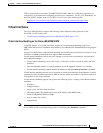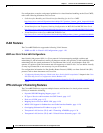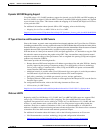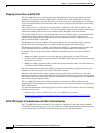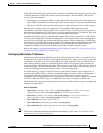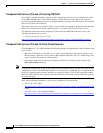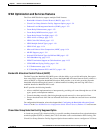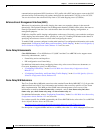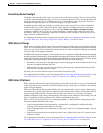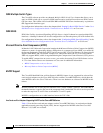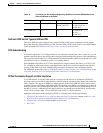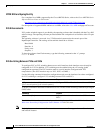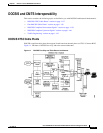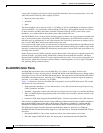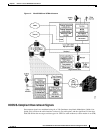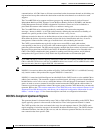
1-133
Cisco uBR7200 Series Universal Broadband Router Software Configuration Guide
OL-2239-05
Chapter1 Overview of Cisco uBR7200 Series Software
cops tcp window-size
Frame Relay Router ForeSight
ForeSight is the network traffic control software used in some Cisco switches. The Cisco Frame Relay
switch can extend ForeSight messages over a User-to-Network Interface (UNI), passing the backward
congestion notification for VCs. ForeSight allows Cisco Frame Relay routers to process and react to
ForeSight messages and adjust VC level traffic shaping in a timely manner.
ForeSight must be configured explicitly on both the Cisco router and the Cisco switch. ForeSight is
enabled on the Cisco router when Frame Relay traffic shaping is configured. However, the router's
response to ForeSight is not applied to any VC until the frame-relay adaptive-shaping foresight
command is added to the VCs map-class. When ForeSight is enabled on the switch, the switch will
periodically send out a ForeSight message based on the time value configured. The time interval can
range from 40 to 5000 milliseconds.
For additional information about configuring frame relay, refer to “Configuring Frame Relay” in the
Cisco IOS Wide-Area Networking Configuration Guide, Release 12.2 on Cisco.com.
ISDN Advice of Charge
ISDN Advice of Charge (AOC) allows users to obtain charging information for all calls during the call
(AOC-D) or at the end of the call (AOC-E) or both. Users must have subscribed through their local ISDN
network to receive the AOC information from the switch. No router configuration changes are required
to retrieve this call charging information.
The ISDN AOC feature also supports, for the AOC-D service, an optional configurable short-hold mode that
provides a dynamic idle timeout by measuring the call charging period, based on the frequency of the AOC-D
or the AOC-E message from the network. The short-hold mode allows users to track call costs and to control
and possibly reduce tariff charges. The short-hold mode idle time will do the following:
• Disconnect a call just prior to the beginning of a new charging period if the call has been idle for at
least the configured minimum idle time.
• Maintain the call to the end of the current charging period past the configured idle timeout if the
time left in the charging period is longer.
Incoming calls are disconnected using the static dialer idle timeout value.
For configuration information, refer to the chapter titled “Configuring ISDN Special Signalling” in the
Cisco IOS Dial Services Configuration Guide: Terminal Services, Release 12.1 on Cisco.com.
ISDN Caller ID Callback
ISDN caller ID callback allows the initial incoming call from the client to the server to be rejected based
on the caller ID message contained in the ISDN setup message, and it allows a callback to be initiated
to the calling destination.
ISDN caller ID callback allows great flexibility for you to define which calls to accept, which to deny,
and which calls to reject initially but for which the router should initiate callback. The feature works by
using existing ISDN caller ID screening, which matches the number in the incoming call against
numbers configured on the router, determining the best match for the number in the incoming call, and
then, if configured, initiating callback to the number configured on the router.
When a call is received, the entire list of configured numbers is checked and the configuration of the
best match number determines the action:
• If the incoming number is best matched by a number that is configured for callback, then the
incoming call is rejected and callback is initiated.
• If the incoming number is best matched by another entry in the list of configured numbers, the call
is accepted.
• If the incoming number does not match any entry in the configured list, the call is rejected and no
callback is started.
For configuration information, refer to the chapter titled “Configuring ISDN Caller ID Callback” in the
Cisco IOS Dial Services Configuration Guide: Network Services, Release 12.1 on Cisco.com.



